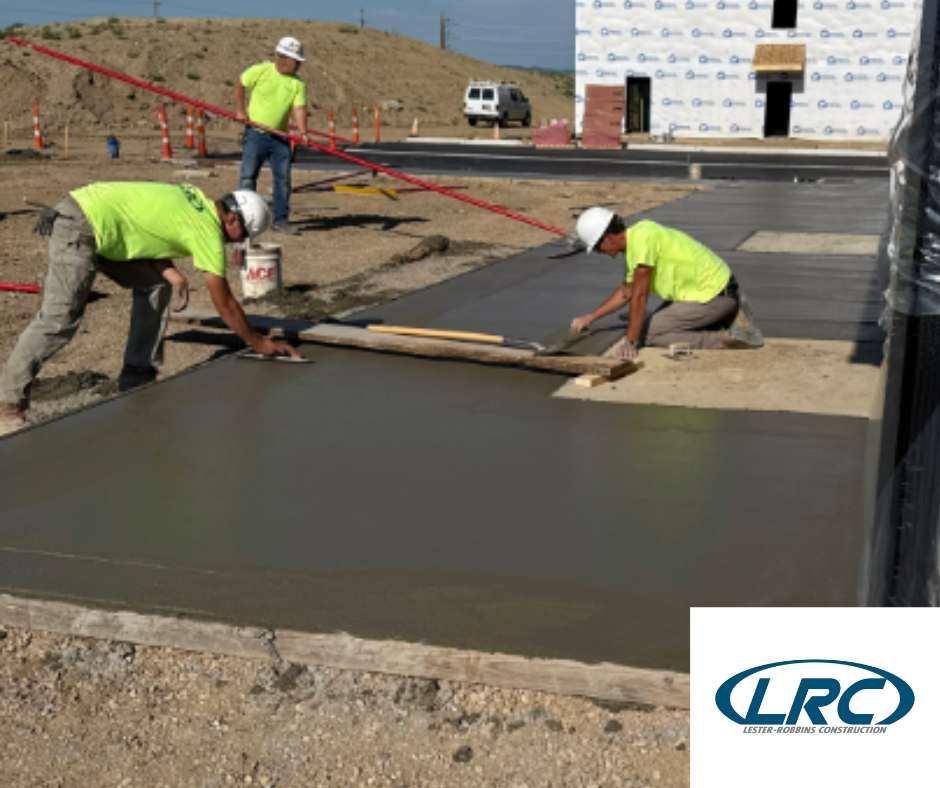Our Safety Tips: LRC is Your Foundation for Security
– By #Lester-Robbins Construction

At Lester-Robbins Construction, safety is not just a priority, it’s a core value that drives every aspect of operations. As a leader in the concrete construction industry, the company is committed to equipping teams with top-tier safety practices. Through comprehensive training and strict adherence to OSHA guidelines, the goal is to prevent concrete-related hazards and foster a culture of safety throughout the Black Hills region.
Identifying and Managing Concrete Hazards
Concrete work presents a range of risks that demand attention and expertise. From slips and trips on uneven surfaces to injuries caused by lifting heavy materials, the dangers are varied. Equipment-related incidents, particularly those involving mixers and machinery, require constant caution.
Health risks such as exposure to silica dust can lead to serious respiratory issues. Emphasizing the use of proper personal protective equipment (PPE) and encouraging open conversations about physical and chemical hazards helps ensure safer work environments. Safety education empowers workers to handle concrete work effectively and responsibly.
The Role of Personal Protective Equipment (PPE)
PPE serves as the first line of defense in maintaining a safe job site. Essential PPE includes:
- Hard hats
- Safety glasses
- Gloves
- Mucking and work boots
- Respiratory protection for dusty tasks
Lester-Robbins Construction underscores the importance of not only wearing PPE but also maintaining it. Regular inspections and prompt replacement of damaged gear help uphold high safety standards. Investing in quality PPE enhances both productivity and morale, reinforcing the company’s commitment to worker safety.
Safety Procedures Taken to Avoid Most Common Injuries Include:
- Mucking Boots
o Concrete burns are a common injury within the construction industry, particularly the concrete-construction industry. The good news is that they are easily preventable! Proper mucking boots are a requirement for employees anytime they will be working in the concrete. On certain projects, the concrete will be taller than the height of the mucking boots. In this scenario, our supervisors provide duct tape for our employees to tightly wrap around the top of their boot. This prevents any concrete from getting into the mucking boot or under clothing.
- Safety Glasses
o Dust, rocks, bits of concrete, and other materials can pose a risk to an individual’s eyes, whether it be from using a power tool or just working in the concrete. Safety glasses are another non-negotiable safety item that we provide to our employees upon hire and require on the job site. Our office ensures that we keep plenty of OSHA-approved safety glasses on hand!
- Keeping the work site organized and cleaned
o Site preparation and site clean up are a less obvious, but just as effective way that we can practice jobsite safety. On every single project there is site prep and clean up that aids in maintaining a safe, organized environment. Both are a way to be certain that tools, machinery, and equipment are in their proper spot, preventing further safety hazards.
- Proper hydration
o Another important safety measure is proper hydration throughout the work day. Construction, specifically concrete work, is strenuous work that taxes the body. Prioritizing hydration throughout the day is a simple way to prevent heat illness, fatigue, and dehydration, especially during the warm summer months.
Safe Handling and Lifting Techniques
Proper lifting techniques are essential to preventing injuries. Workers are trained to:
- Assess loads before lifting
- Bend at the knees and lift with their legs
- Keep a straight back and avoid twisting
For heavier loads, team lifting and mechanical assistance are standard. These practices are integrated into safety training to prepare workers for the physical demands of concrete work.
Implementing Site Safety Protocols
A well-developed safety plan is vital for every project. Site-specific protocols address the unique challenges of concrete construction and include:
- Regular safety briefings and toolbox talks
- Emergency preparedness, including first aid training
- Clearly marked evacuation routes and accessible first aid kits
Preparation is key to effective emergency response. Our Supervisors are trained to act swiftly and efficiently, minimizing risks and maintaining safety.
Ongoing Training and Safety Education
Safety is a continuous commitment. Training programs keep workers informed about the latest OSHA regulations and industry best practices. Regular audits and reinforcement of safety protocols help maintain high standards.
Open communication is encouraged, allowing workers to share concerns and contribute to a proactive safety culture. Staying informed and engaged strengthens concrete safety across the board.
Your Safety, Our Commitment
Lester-Robbins Construction understands the complexities of concrete work and refuses to compromise on safety. A proactive approach—featuring ongoing training, thorough risk assessments, and proper equipment use—ensures safety remains central to every operation.
Our company takes pride in being safety-first, dedicated to ensuring every worker returns home safely. That’s the Lester-Robbins difference.
Last Modified:
